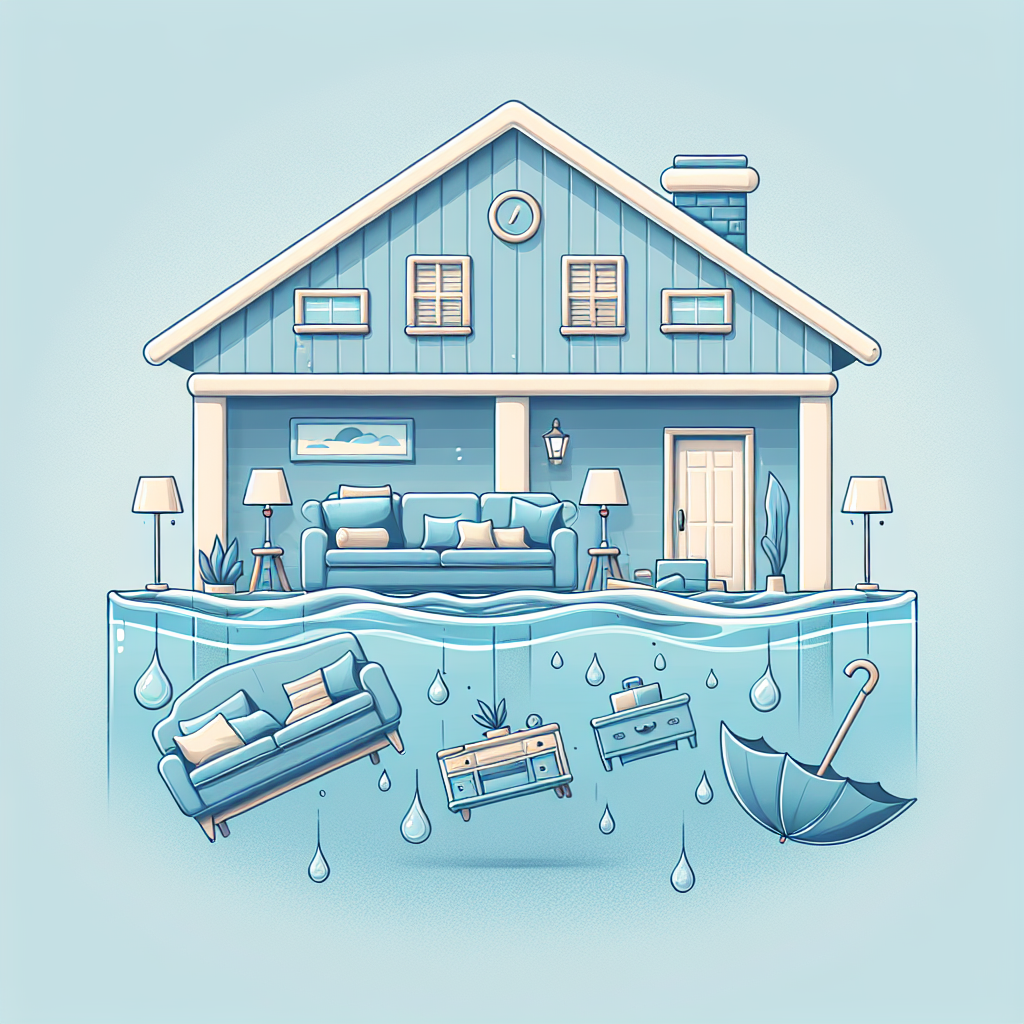Filed under Home Insurance on
State Farm Home Insurance Water Damage Coverage Guide

Why Water Damage Deserves Your Full Attention
A burst pipe at 2 a.m. can turn a quiet night into a race against rising water. Water claims are among the most frequent and expensive events for homeowners, with average losses often landing in the five-figure range. That is why understanding how your policy responds is not optional—it is essential to protecting your home, savings, and peace of mind. If you are a State Farm customer or considering a switch, getting familiar with State Farm home insurance water damage coverage can help you prevent surprises and make smarter decisions before a leak becomes a loss.
Insurance industry data points to several trends: non-weather water damage (think plumbing failures and appliance leaks) is a leading cause of claims; homes with proactive leak detection devices experience fewer severe losses; and policy endorsements can transform a costly out-of-pocket event into a covered claim. With the right preparation and understanding, you can cut through jargon, identify coverage gaps, and target upgrades that matter most.
How Home Insurance Approaches Water Damage
The backbone: sudden and accidental
Most homeowners policies cover water damage when it is sudden and accidental. This phrase is the heartbeat of coverage. It typically means a quick, unexpected event, not gradual wear or unnoticed seepage over months. A supply line bursting behind your washing machine? That is sudden and accidental. A slow drip from an old valve that has been staining drywall for a year? Usually not.
Policy forms and scope
Many policies are based on standardized forms such as HO-3 or HO-5, but insurers often customize wording by state. The scope of coverage varies by location and policy tier. While an HO-5 may offer broader protection for personal property than an HO-3, the treatment of water damage exclusions and add-ons can be similar. Always confirm the exact language in your declarations page and endorsements.
Named perils vs. open perils
Dwelling coverage is commonly written on an open-perils basis—everything is covered unless excluded—while personal property may be named-perils—covered only if listed. This difference matters in water events. Even when a wall is covered, damaged contents could be treated differently, especially if the cause is disputed or not explicitly listed.
What State Farm Typically Covers for Water Losses
While policy terms vary, many homeowners find coverage for the kinds of water incidents most likely to occur in a modern house. Understanding where State Farm home insurance water damage coverage usually responds can help you plan for the risk you actually face day to day.
Commonly covered scenarios
- Sudden discharge from plumbing, heating, or air conditioning systems, and fire sprinkler leakage
- Accidental overflow from appliances such as washing machines, dishwashers, or water heaters
- Water damage following a storm-created opening, like wind tearing off shingles and rain entering through the newly damaged area
- Tear-out access: the reasonable cost to tear out and replace parts of the home to access a leaking pipe when the leak itself is from a covered cause
What parts of the policy may respond
- Dwelling coverage: for structural elements, including floors, walls, ceilings, built-in cabinetry, and subfloors
- Personal property coverage: for belongings, from furniture to electronics, subject to policy limitations and personal property valuation method
- Loss of use: for additional living expenses if your home is uninhabitable during repairs, up to policy limits
- Mold remediation: frequently limited by sublimits and, in many policies, requires a covered water event to trigger coverage
Note that coverage depends on the cause and timing of the water intrusion. The same wet floor can be fully covered, partially covered, or excluded depending on the event that led up to it.
What Is Generally Not Covered
Excluded or limited causes
- Maintenance-related issues: long-term seepage, concealed leaks ongoing for months, or failure to maintain appliances or roof
- Flood: water entering from outside at ground level or from storm surge requires separate flood insurance
- Sewer or drain backup: typically excluded unless you add a specific endorsement with its own limit and deductible
- Groundwater and hydrostatic pressure: water pushing through foundation walls without a covered cause
- Mold unrelated to a covered water event: mold from humidity or deferred maintenance is usually excluded
Exclusions aim to separate insurable, sudden losses from predictable wear and tear or external catastrophes like floods. Your strategy should be to plug these gaps proactively with endorsements or companion policies.
Key Endorsements and Options to Consider
Endorsements modify your base policy and can be the difference between a manageable setback and a major financial hit. Reviewing add-ons alongside State Farm home insurance water damage coverage ensures you match your policy to your home’s specific vulnerabilities.
Water backup and sump overflow
This endorsement is designed for damage from water backing up through sewers or drains or overflowing from a sump pump. If your home has a basement, clay sewer laterals, or heavy tree roots nearby, this add-on can be a high-value upgrade. It typically comes with:
- A separate coverage limit (often available in several tiers)
- A distinct deductible
- Coverage for cleanup, damaged finishes, and lost personal property up to the endorsement’s limit
Enhanced mold remediation limits
Base policies often include relatively low mold sublimits. If your climate is humid or your home uses materials that can easily host mold after a leak, an increased limit endorsement may better align with real-world remediation costs.
Replacement cost for personal property
Many policies default to actual cash value for personal items, which deducts depreciation. Upgrading to replacement cost can significantly improve claim outcomes after water damages high-use items like furniture and electronics.
Service line and equipment breakdown
In some regions, insurers offer service line coverage for underground pipes and wiring connecting your home to public utilities. Equipment breakdown can help when a mechanical or electrical failure causes a water loss. Availability varies; ask your agent what is offered in your state.
Flood Coverage: A Separate Policy You May Need
What counts as a flood
Insurance defines flood as water covering at least two acres of land or affecting two or more properties, often from heavy rain, river overflow, storm surge, or rapid snowmelt. Homeowners policies generally exclude this peril. To protect against it, consider a National Flood Insurance Program (NFIP) policy or a private flood policy.
Timing and limits
NFIP policies typically have a 30-day waiting period, so plan ahead of storm seasons. Coverage for basements is limited, particularly for finished areas and contents. If you live near a coastline, in a low-lying area, or in a community with aging infrastructure, pair your homeowners policy with flood insurance for a more complete safety net. This companion approach works alongside State Farm home insurance water damage coverage to create a broader shield.
Deductibles, Limits, and How Claim Payments Work
Understanding your deductible
Most water claims fall under the all-perils deductible, although some endorsements carry their own. Choose a deductible you can comfortably afford in an emergency. A higher deductible can lower premium, but if it discourages you from filing a legitimate claim, it may not be the right fit.
ACV vs. RCV
Actual cash value (ACV) subtracts depreciation from your payout, while replacement cost value (RCV) reimburses you for the cost to replace or repair with similar materials. Many policies pay ACV first and release recoverable depreciation after repairs are completed. Keep receipts and contractor invoices organized to recover all amounts owed.
Sublimits and special caps
Several water-related costs can fall under sublimits:
- Mold remediation
- Water backup endorsement limits
- Special property categories like jewelry or collectibles
- Ordinance or law coverage for bringing repairs up to current code
Read your declarations page and endorsements for these figures. They are the hidden gears that determine how well your policy performs in a crisis.
How to File a Strong Water Damage Claim
When minutes matter, you need a crisp plan. The aim is to protect your property, document thoroughly, and communicate clearly so your policy can work as intended under State Farm home insurance water damage coverage.
Immediate steps
- Shut off the water at the main valve, if safe and accessible
- Prevent additional damage: move valuables, place buckets, and ventilate the area
- Document everything: capture wide and close-up photos and videos of the source, damage, and any standing water
- Call your insurer or agent to report the claim promptly
- Contact a reputable water mitigation company for extraction and drying; ask them to preserve materials for inspection
Work clean, work fast
Keep a log of calls, save receipts, and do not discard damaged items until the adjuster has seen them or has given permission. Reasonable emergency repairs are typically covered, but permanent repairs should wait for the adjuster’s go-ahead, unless delay risks further damage.
Coordinate with the adjuster
Share your documentation, contractor estimates, and any relevant warranties or maintenance records. If you have replacement cost on personal property, track the replacement prices and keep proof of purchase to reclaim depreciation.
Prevention Checklist and Potential Discounts
Routine maintenance that pays off
- Replace rubber supply lines on washers and toilets with braided stainless steel
- Inspect and clean gutters twice a year; ensure downspouts drain away from the foundation
- Winterize: insulate exposed pipes and let faucets drip during deep freezes
- Maintain your roof: replace damaged shingles, seal flashing, and clear debris
- Drain and flush your water heater per manufacturer recommendations
Smart devices for smart savings
- Install point-of-use leak sensors under sinks, behind the washer, near the water heater, and around HVAC systems
- Consider a whole-home automatic shutoff valve with flow monitoring; these devices can halt major losses
- Set up text alerts for abnormal water usage or temperature drops
Many insurers, in certain states, offer premium credits or incentives for qualifying leak detection and shutoff systems. Ask your agent what is recognized and how to document installation for potential savings.
Cost Factors and How Claims Affect Premiums
What drives your rate
- Home age and materials: older plumbing or polybutylene pipes can raise risk
- Location: frequency of freeze events, sewer infrastructure, and soil conditions
- Home features: finished basements, hardwood floors, and high-end finishes increase severity of potential claims
- Protective devices: monitored leak detection and automatic shutoff can improve your profile
- Deductible selection: higher deductibles generally reduce premium
Claim history matters
One or more water claims can lead to surcharges or loss of claim-free discounts. Before filing a minor claim that sits barely above your deductible, weigh the short-term payout against potential long-term premium effects. Your agent can help model the trade-offs.
Scenario Snapshot: Is It Covered?
- Frozen pipe bursts while you are away: typically covered if you maintained heat or followed policy requirements for winterizing
- Dishwasher supply line fails suddenly: commonly covered for resulting damage; the appliance part itself may not be
- Rain enters through a pre-existing roof leak: often excluded as maintenance
- Sewer backs up into basement: requires a water backup endorsement
- River overflows into your yard and basement: requires separate flood insurance
Expert Tips to Strengthen Your Coverage
Audit your policy annually
Homes change and so do risks. A kitchen remodel or finished basement can outpace your coverage if you do not update limits and endorsements. Review your declarations page each renewal and confirm that important sublimits, like mold and water backup, match your exposure.
Get estimates for endorsements
Ask your agent for several tiers of water backup limits and price differences between ACV and RCV for personal property. Understanding the premium impact of each choice lets you build a tailored plan at a comfortable cost.
Ask about documentation standards
Knowing what photos, measurements, and invoices an adjuster needs, before a loss happens, helps you move fast under pressure. Clarify whether electronic submissions are preferred and how to track mitigation costs.
FAQs: Quick Answers to Common Questions
Does homeowners insurance cover mold?
Often only when it results from a covered water event, subject to mold sublimits. Mold from humidity or long-term leaks is usually excluded unless you have an applicable endorsement.
Is the source of the leak covered?
Repairs to walls or floors to access a covered leak are often covered, but the faulty part itself may not be. Policies distinguish between fixing damage caused by water and replacing worn-out components.
Will a claim increase my premium?
It can. The effect depends on claim severity, frequency, your state’s rating rules, and your insurer’s underwriting. Discuss with your agent before filing small claims.
Do I need flood insurance if I am not in a high-risk zone?
Consider it. A substantial share of flood claims come from outside designated high-risk areas. Premiums in moderate-to-low risk zones are typically lower, and the protection can be valuable.
How does State Farm home insurance water damage coverage handle slow leaks?
Gradual or repeated seepage is commonly excluded. Coverage is strongest for sudden and accidental discharge. If your home is prone to hidden leaks, invest in leak detection and maintenance to prevent uncovered losses.
Step-by-Step Claim Preparation Checklist
- Secure safety: cut power to wet areas if water is near outlets or electrical panels
- Stop the source: close the main shutoff valve or call a plumber
- Document immediately: take timestamped photos and video from multiple angles
- Contain and mitigate: towels, fans, dehumidifiers, and professional extraction
- Notify your insurer and follow guidance on contractors and preservation of evidence
- Track all costs: keep a spreadsheet of purchases, mitigation bills, and temporary housing expenses
- Coordinate repairs: obtain written estimates from licensed contractors and share with the adjuster
- Close the loop: submit final invoices for depreciation recovery if your policy allows it
What to Discuss With Your Agent
- Endorsement availability and pricing for water backup, mold, and service lines
- Personal property valuation: ACV vs. replacement cost
- Appropriate dwelling limits after renovations
- Discounts for leak detection and automatic shutoff devices
- How your deductible structure affects out-of-pocket risk
Putting It All Together
A strong water damage strategy blends prevention, smart coverage selection, and quick action in an emergency. Start by reviewing your declarations page for deductibles, mold sublimits, and any water backup endorsement. Consider your home’s unique vulnerabilities—finished basements, older plumbing, or frequent freezes—and adjust your policy and devices accordingly.
When you think in layers—maintenance, technology, and insurance—you reduce both the likelihood and severity of losses. Smart valves and sensors stop small leaks from becoming catastrophes. Annual roof and plumbing checkups head off maintenance exclusions. And well-chosen endorsements keep major events from becoming budget-busting setbacks.
Final Takeaway
Your home is a system, and water is one of its greatest stress tests. The right coverage and preparation can turn an unforeseen leak into a manageable repair instead of a financial detour. Review how State Farm home insurance water damage coverage aligns with your home today, ask targeted questions about endorsements and limits, and shore up weak points with practical upgrades. A few hours of preparation now can save weeks of disruption later.
If you are unsure where to begin, map your home’s likely water risk zones—kitchen, laundry, bathrooms, water heater, HVAC, and basement—and match each zone with prevention tools and policy protections. With a focused plan built around State Farm home insurance water damage coverage, you will be positioned to respond fast, file confidently, and recover fully when water tries to write your home’s story.




